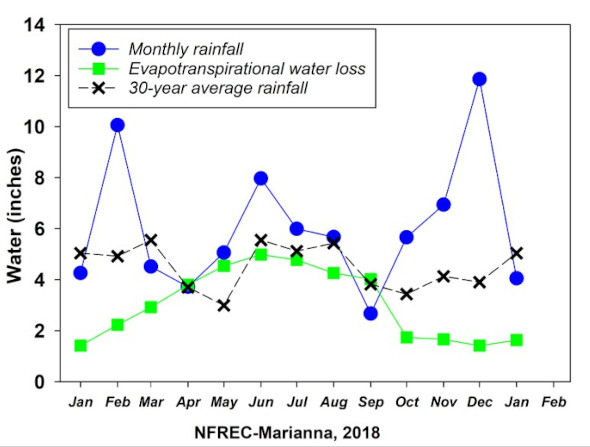By Cheryl Mackowiak
Did you know that soil nitrogen might be more susceptible to leaching losses in winter than during the summer, even if you do not apply nitrogen fertilizer in the fall or winter? Nitrate is the nitrogen form most susceptible to leaching, and it is also the dominant form of plant-available nitrogen found in most surface soils. Nitrate may originate from 1) fertilizers that you and your livestock apply, 2) biologically mediated processes underground (dinitrogen fixation and organic matter mineralization), and 3) atmospheric nitrogen deposition (dry particulates and rainwater). However, atmospheric deposition is often a relatively minor contributor (less than 10 lbs N/acre/year).
Important as it is to control nitrogen inputs, water directs nitrate movement in the soil, including leaching. There is a big difference between summer and winter water dynamics in temperate regions of the country, due to differences in daylength, temperature and humidity. Water applied to the soil surface through rainfall or irrigation is susceptible to evaporative loss. Lower humidity and higher temperature increase evaporative water loss. Additionally, when a plant takes up soil water, it also losses a portion of that water through stomatal pores in their leaves through a process called transpiration. As with the soil, lower humidity and warmer temperatures result in greater transpiration water loss from the plants. The combination of evaporative loss and transpiration loss is called evapotranspiration (ET). Many institutions, such as the UF-IFAS
Florida Automated Weather Network (FAWN), provide daily ET at each of their weather station locations that the public can be access online. You can estimate the likelihood for nitrate leaching over time by comparing rainfall against ET on a daily basis. Remember that If you irrigate, you also need to include the acre-inches of water via irrigation to the rainfall inputs.
In much of Florida, we often find that ET values often exceed rainfall values during the summer months, but then rainfall values greatly exceed ET values during much of the winter and spring (Figure 1). Knowing that soil moisture directs where nitrate travels, then nitrates should remain fairly close to the soil surface when ET ≥ rainfall. In contrast, we may have nitrates moving down past the root zone during times when ET < rainfall, and the more rainfall or irrigation that is in excess of ET, the greater the nitrate leaching potential. If nitrate moves below the maximum rooting depth, it might never be removed through plant uptake, and eventually can leach into groundwater or into other water bodies via seeps or other sublateral flow.

Figure 1. Example of the seasonal changes in rainfall and evapotranspiration at NFREC, Marianna, FL. Blue circles represent monthly rainfall from January 2018 to January 2019. Green squares represent reference evapotranspiration (ETo), and the black X s represent the 30-year average rainfall at the same location. Note how much greater rainfall is compared to ETo during winter months than summer months Credit: Cheryl Mackowiak, UF/IFAS
Using a winter or cool-season cover crop, such annual ryegrass or various small grains (cereal rye, oats, etc.), can help to mitigate nitrate leaching losses. At the North Florida Research and Education Center (NFREC), we are measuring nitrate leaching losses (below five feet), among different cropping and grazing systems during the winter (Figure 2). Last winter we found that a cover crop (cereal rye/oat mixture) planted over cotton and fertilized with 30 lbs N/acre, lost 12 lbs N/acre over the winter season, which was similar nitrate leaching losses as leaving the field fallow (unsprayed weeds and no winter cover crop forage income). However, if that row crop cover was grazed, we reduced nitrate leaching losses by 30 to 50%, and created high-quality winter grazing for cattle.
Figure 2. Experimental site at NFREC, Marianna with cattle grazing winter cover established over summer cotton Credit: Dr. Jose Dubeux, Agronomist, UF/IFAS NFREC, Marianna
When you receive two to three inches or more of rainfall in a day, even a cover crop will not eliminate most nitrate leaching losses, but as long as the plants are healthy and managed well, you may improve your production system while also protecting our water resources. Additionally, the cover crop residues above- and below ground provide another source of slow-release nitrogen that will eventually mineralize into plant-available nitrate, to once again, feed your summer crops and pasture. Now is a good time to procure your winter cover seed for planting in late October through December.For the recommended varieties in Florida, use the following link:
2020 Cool-Season Forage Variety Recommendations for Florida.